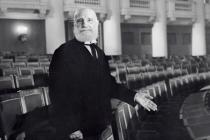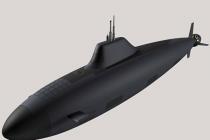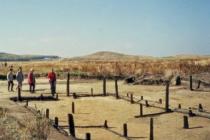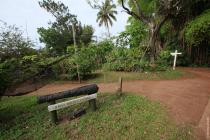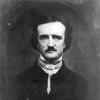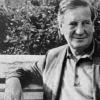During the night of November 17, our troops fought with the enemy in the Stalingrad region, northeast of Tuapse and southeast of Nalchik. There were no changes on other fronts.
In the area of Stalingrad, our troops repulsed the attacks of small enemy groups. In the southern part of the city, the fighters of the N-th part were active. More than 100 enemy rifles and other trophies have been picked up on the battlefield. The gun crews of sergeants Ivantsov and Kratar, firing at direct fire, destroyed up to a company of German infantry. In another sector, the fire of our artillerymen dispersed up to an enemy infantry battalion.
Northwest of Stalingrad, artillerymen and mortars under the command of Comrade. Poluektov destroyed 4 German dugouts, suppressed the fire of two mortar batteries and dispersed three platoons of enemy infantry. The N-th division undertook reconnaissance in force. The scouts broke into the enemy's location, blew up 2 bunkers, destroyed up to 50 Nazis and, having captured 2 heavy machine guns and 3 mortars, returned to their unit.
Southeast of Nalchik, our troops were actively fighting. In one section, a group of our tanks wedged into the enemy defenses. The tank crew under the command of senior lieutenant Parshin crushed 3 anti-tank guns and 4 German vehicles with caterpillars. The tank of senior lieutenant Tereshchenko destroyed up to a platoon of infantry and destroyed several machine-gun points of the enemy. The Germans tried to close the gap and hastily abandoned 12 tanks. In the ensuing battle, our tankers knocked out 4 enemy tanks.
To the northeast of Tuapse, the German forces, which were numerically superior, attacked the height, which was defended by the N-unit. Soviet fighters with machine-gun fire brought disorder into the ranks of the enemy, and then launched a counterattack. The Nazis retreated, leaving 160 corpses on the battlefield.
On the Kalinin Front, the reconnaissance group of the N-th unit penetrated behind enemy lines and defeated the German garrison in one of the settlements. 90 Germans, 6 machine guns and an automatic cannon were destroyed. Taken prisoners.
Anti-aircraft artillery shot down 2 enemy aircraft.
A detachment of Belarusian partisans derailed two enemy railway echelons. 2 locomotives and 26 wagons were destroyed. During the crash, 110 German soldiers and officers were killed. Another detachment of Belarusian partisans made several attacks on small enemy garrisons and exterminated 85 Nazis.
Reportedly, the crew of one German submarine refused to go to sea. The entire crew of the submarine was arrested and imprisoned in the Esterwegen concentration camp in Emsland, near Papenburg. In connection with this, the Gestapo is conducting a purge among the personnel of the fleet.
During November 17, our troops fought with the enemy in the Stalingrad region, northeast of Tuapse and southeast of Nalchik. There were no changes on other fronts.
In the area of Stalingrad, our troops repelled numerous attacks by the Nazis. In the factory part of the city in one area, after two days of continuous fighting, the enemy pressed our units. During the day, according to incomplete data, the Germans lost up to 1,000 soldiers and officers killed and wounded. 60 vehicles, 5 guns, 15 mortars, 28 machine guns were destroyed and 10 enemy bunkers were destroyed. Senior Sergeant Comrade Feobanov shot down a German bomber with fire from an anti-tank rifle.
Northwest of Stalingrad, our units defended their positions and exchanged fire with the enemy. The soldiers of the unit commanded by Comrade. Novikov, machine-gun fire destroyed 75 Nazis who were building wire fences. The artillerymen of the unit, where the commander of Comrade. Stolboshinsky, destroyed 7 enemy bunkers and dugouts with their garrisons, destroyed 2 heavy machine guns, a mortar battery and destroyed two platoons of German infantry.
Southeast of Nalchik, Soviet troops were actively fighting. The division under the command of Comrade. Bely was attacked and knocked out by the Germans from fortified positions in the region of the same height. Tankers under the command of Comrade. Filippov was knocked out and burned 5 enemy tanks and exterminated to a company of German infantry.
The captured soldiers of the 93rd German Motorized Regiment and the 43rd Motorcycle Battalion of the 13th German Panzer Division reported heavy losses suffered by the division in recent battles. In many companies, 10-15 soldiers remained, and all the rest were killed or wounded.
Northeast of Tuapse, in the sector of the N-th connection, the German infantry, supported by aviation, tried to break through our line of defense. In this battle, up to 400 Nazis were destroyed.
On one of the sections of the Volkhov Front, two regiments of enemy infantry, trying to return the settlement occupied by our troops, attacked our positions. Soviet fighters repelled six enemy attacks and exterminated up to a regiment of Nazis. By evening, having brought up reinforcements, the Germans, supported by strong artillery and mortar fire, again went on the offensive. The enemy managed to break into the outskirts of the settlement. Our divisions are engaged in stubborn street battles.
Partisan detachments operating in the Soviet regions captured by the Germans, from November 9 to 12, derailed 34 enemy railway military echelons. 15 steam locomotives, 440 wagons, platforms and tanks were smashed. During the same time, the partisans exterminated 940 German soldiers and officers and blew up 7 railway and highway bridges.
Josef F., a soldier of the 396th Infantry Regiment of the 216th German Infantry Division, who voluntarily went over to our side, said: “In the city of Vitebsk, at the station, I saw a large train, the cars of which were sealed. Heartbreaking screams came from them. The sentries guarding the echelon told me that there were Russian women in the cars, who were forcibly sent to Germany. When boarding the car, many of them were beaten, and 6 women were shot.”
The food situation in Romania is continuously deteriorating. The Romanian newspaper Kurentul writes: “Corn is the country's staple food. Therefore, corn is needed for the tranquility of the vast majority of the population. We repeat, the question of internal order comes down to the supply of corn. However, we had a very unsuccessful agricultural year.” The harvest of wheat and other crops was taken almost entirely by the Germans. Hitler left corn to the Romanians, but there is not enough of it either. Rumania's venal ruling clique is already fearful of hunger riots. This anxiety of Hitler's lackeys is reflected in the pages of many Rumanian newspapers.
This period is the period of a radical turning point in the Great Patriotic War. During this period, the most important events were the Battle of Stalingrad, the Battle of Kursk, the Battle of the Dnieper, the Tehran Conference. It is important to note the outstanding personalities of that period. Soviet Union: leader - I. V. Stalin, military leader - G. K. Zhukov; on the part of Germany: the leader - A. Hitler, the commander - Paulus.
By 1942, the Nazi troops were stretched from the Baltic to the Black Sea, i.e. cut off from supply bases. At this time, the partisan movements of the Soviet Union inflicted enormous damage. The plan of the Soviet command was developed. The operation, codenamed "Uranus", meant the encirclement and defeat of German troops near Stalingrad.
As a result of the winter offensive of the Soviet army, a ledge was formed on the front in the Kursk region, facing the enemy.
The reason for the transition to the defensive in this area was intelligence data on the impending offensive of Nazi German troops on the flanks of the Kursk salient during Operation Citadel.
It is necessary to highlight the role of Zhukov in the development of the operation on the Kursk Bulge. Zhukov proposed to conduct a defensive battle, wear down the enemy troops and defeat them by conducting counterattacks on the attackers at a critical moment (Operations Kutuzov and Rumyantsev). During the Battle of Kursk, Zhukov coordinated the actions of the Western, Bryansk, Steppe and Voronezh fronts.
The victory in the Battle of Kursk made it possible to liberate a significant territory of the Soviet Union.
The successes of the Soviet army and the need to resolve important issues of interaction between the allies in the war became the reason for holding the Tehran Conference.
Stalin played an active role in the conference. He opposed Churchill's plan to replace it with operations in Italy and the Balkans. Stalin supported Roosevelt's proposal to create an international
peacekeeping organizations. He spoke out against the plans for the division of Germany and announced the readiness of the USSR to enter the war against Japan after the final defeat of the German army. The conference reaffirmed the resolve of the three states to work together both in times of war and in subsequent times of peace.
The period under review was the time of a radical change in the course of the Great Patriotic War. During the offensive phase of the Battle of Stalingrad, the Battle of Kursk, the Battle of the Dnieper and other major offensive operations, it was possible to seize the strategic initiative and liberate a significant part of the occupied Soviet territory. During this period, conditions were created for the complete liberation of the territory of the USSR from the invaders, the liberation of the countries of Eastern Europe and the final defeat of Nazi Germany, which happened at the next, final stage of the Great Patriotic War.
November 19, 1942 76 years ago The beginning of the counteroffensive of the Soviet troops near Stalingrad (the beginning of the Stalingrad operation).
The Battle of Stalingrad (November 19, 1942 - February 2, 1943) is one of the largest strategic operations of the Soviet troops in the Great Patriotic War.
Its code name is Operation Uranus. The battle included two periods.
The first is the Stalingrad strategic defensive operation (July 17 - November 18, 1942), as a result of which not only the enemy’s offensive power was crushed and the main strike force of the German army on the southern front was bled, but also the conditions were prepared for the transition of Soviet troops to a decisive counteroffensive.
The second period of the battle - the Stalingrad strategic offensive operation - began on November 19, 1942.
During the operation, Soviet troops surrounded and destroyed the main forces of the German armies.

In total, during the Battle of Stalingrad, the enemy lost about one and a half million people - a quarter of his forces operating on the Soviet-German front.

The victory of the Soviet troops in the Battle of Stalingrad was of great political and international significance, it had a significant impact on the development of the Resistance Movement on the territory of European states occupied by the fascist invaders.

As a result of the battle, the Soviet armed forces wrested the strategic initiative from the enemy and held it until the end of the war.

In the Battle of Stalingrad, hundreds of thousands of Soviet soldiers showed unparalleled heroism and high military skill. 55 formations and units were awarded orders, 179 - converted into guards, 26 received honorary titles. About 100 fighters received the title of Hero of the Soviet Union.
Stalingrad became a symbol of the steadfastness, courage and heroism of the Soviet people in the struggle for the freedom and independence of the motherland.
On May 1, 1945, by order of the Supreme Commander-in-Chief, Stalingrad was awarded the honorary title of Hero City.
On November 19, 1942, Operation Uranus began - the strategic offensive of the Soviet troops near Stalingrad, which led to the encirclement and subsequent defeat of the Paulus army. Having suffered a heavy defeat in the Battle of Moscow and suffered huge losses, in 1942 the Germans could no longer advance along the entire Soviet-German front. Therefore, they decided to concentrate their efforts on his southern flank. Army Group "South" was divided into two parts - "A" and "B". Army Group A was intended to attack the North Caucasus with the aim of capturing oil fields near Grozny and Baku. Army Group B, which included the 6th Army of Friedrich Paulus and the 4th Panzer Army of Hermann Goth, was supposed to move east towards the Volga and Stalingrad. This army group initially included 13 divisions, in which there were about 270 thousand people, 3 thousand guns and mortars and about 500 tanks.
On July 12, 1942, when it became clear to our command that Army Group B was advancing on Stalingrad, was created Stalingrad Front. The front included the 62nd Army advanced from the reserve under the command of General Kolpakchi (from August 2 - General Lopatin, from September 5 - General Krylov, and from September 12, 1942 - Vasily Ivanovich Chuikov), 63rd, 64th armies, also the 21st, 28th, 38th, 57th combined-arms and 8th air armies of the former Southwestern Front, and from July 30 - the 51st Army of the North Caucasian Front. The Stalingrad Front received the task, defending in a strip 530 km wide, to stop the further advance of the enemy and prevent him from reaching the Volga. By July 17 Stalingrad Front had 12 divisions (160 thousand people in total), 2200 guns and mortars, about 400 tanks and over 450 aircraft. In addition, 150-200 long-range bombers and up to 60 fighters of the 102nd Air Defense Aviation Division (Colonel I. I. Krasnoyurchenko) operated in its lane. Thus, by the beginning of the Battle of Stalingrad, the enemy had superiority over the Soviet troops in people by 1.7 times, in tanks and artillery - in 1.3 and in aircraft - more than 2 times.
Under these conditions, on July 28, 1942, People's Commissar of Defense I. V. Stalin issued No. 227, in which he demanded to strengthen resistance to the enemy and stop his offensive at all costs. The most severe measures were envisaged for those who would show cowardice and cowardice in battle. Practical measures were outlined to strengthen morale and fighting spirit and discipline in the troops. “It’s time to end the retreat,” the order noted. - Not one step back!" This slogan embodied the essence of Order No. 227. Commanders and political workers were tasked with bringing to the consciousness of every soldier the requirements of this order.
(Light tank MZl "Stuart" of the 241st tank brigade near the city of Kalach-on-Don, northeast of Stalingrad)
To strengthen the defense Stalingrad by decision of the front commander, the 57th Army was deployed on the southern face of the outer defensive bypass. Part Stalingrad Front the 51st Army was transferred (Major General T.K. Kolomiets, from October 7 - Major General N.I. Trufanov). The situation in the zone of the 62nd Army was difficult. On August 7-9, the enemy pushed her troops across the Don River, and surrounded four divisions west of Kalach. Soviet soldiers fought in the encirclement until August 14, and then in small groups they began to break through from the encirclement. Three divisions of the 1st Guards Army (Major General K. S. Moskalenko, from September 28 - Major General I. M. Chistyakov) that approached the Reserve Headquarters launched a counterattack on the enemy troops and stopped their further advance.

(in the trenches of Stalingrad ....)

The Soviet defenders used the emerging ruins as defensive positions. German tanks could not move among piles of rubble up to eight meters high. Even if they could move forward, they came under heavy fire from Soviet anti-tank rifles hidden in the ruins of buildings.
Soviet snipers, using the ruins as cover, also inflicted heavy damage on the Germans. So, only one Soviet sniper Vasily Grigorievich Zaitsev during the battle destroyed 225 enemy soldiers and officers, including 11 snipers.

(sniper Vasily Grigorievich Zaitsev)
During the period of defense Stalingrad at the end of September 1942, a reconnaissance group of four soldiers, led by sergeant Pavlov, captured a four-story house in the city center and entrenched in it. On the third day, reinforcements arrived at the house, delivering machine guns, anti-tank rifles (later - company mortars) and ammunition, and the house became an important stronghold in the division's defense system. German assault groups captured the lower floor of the building, but could not capture it entirely. For the Germans, it was a mystery how the garrison on the upper floors was supplied.

(Pavlov's House..)

(Soviet armor-piercers with PTRD)
By the end of the defensive period Battle of Stalingrad The 62nd Army held the area north of the Tractor Plant, the Barrikady plant and the northeastern quarters of the city center, the 64th Army defended the approaches to its southern part. The general offensive of the German troops was stopped. On November 10, they went on the defensive on the entire southern wing of the Soviet-German front, with the exception of sectors in the areas Stalingrad, Nalchik and Tuapse.
The German command believed that after many months of heavy fighting, the Red Army was not in a position to carry out a major offensive and therefore did not take care of covering the flanks. On the other hand, they had nothing to cover the flanks with. the losses suffered in previous battles forced the troops of the would-be allies to be used on the flanks.
Since September, the Headquarters of the Supreme High Command and the General Staff have begun to develop a counteroffensive plan. On November 13, the strategic counteroffensive plan, codenamed "Uranus", was approved by the Headquarters under the chairmanship of I.V. Stalin.
The plan provided for: to direct the main blows against the most vulnerable sectors of the enemy's defense, to the flank and rear of his most combat-ready formations; strike groups to use terrain advantageous for the attackers; with a generally equal balance of forces in the breakthrough areas, by weakening the secondary areas, create a 2.8-3.2-fold superiority in forces. Due to the deepest secrecy in the development of the plan and the enormous secrecy of the concentration of forces achieved, the strategic surprise of the offensive was ensured.
The offensive of the troops of the South-Western and right wing of the Don Fronts began on the morning of November 19 after a powerful artillery preparation. Troops of the 5th tank armies broke through the defenses of the 3rd Romanian army. The German troops tried to stop the Soviet troops with a strong counterattack, but were defeated by the 1st and 26th tank corps introduced into the battle, the advanced units of which went into the operational depth, advancing to the Kalach area. On November 20, the strike force of the Stalingrad Front went on the offensive. On the morning of November 23, the advanced units of the 26th Panzer Corps captured Kalach. On November 23, the troops of the 4th Panzer Corps of the Southwestern Front and the 4th Mechanized Corps of the Stalingrad Front met in the area of the Sovetsky farm, closing the encirclement ring of the Stalingrad enemy grouping in the interfluve of the Volga and Don. The 6th and main forces of the 4th tank armies were surrounded - 22 divisions and 160 separate units with a total strength of 330 thousand people. By the same time, a large part of the outer front of the encirclement was created, the distance of which from the inner one was 40-100 km.

(street fighting…)
On January 8, 1943, the Soviet command presented an ultimatum to surrender to the command of the encircled troops, but on Hitler's orders, it rejected it. On January 10, the liquidation of the Stalingrad cauldron began by the forces of the Don Front (Operation "Ring").

(German prisoners)
At this time, the number of encircled troops was still about 250 thousand, the number of troops of the Don Front was 212 thousand. The enemy stubbornly resisted, but the Soviet troops moved forward and on January 26 cut the group into two parts - the southern one in the city center and the northern one in the area of the tractor factory and the factory "Barricades". On January 31, the southern group was liquidated, its remnants, led by Paulus, surrendered.
On February 2, the northern group was finished. This ended the Battle of Stalingrad.
On November 19, 1942, the counter-offensive of the Red Army near Stalingrad began (Operation Uranus).
The Battle of Stalingrad is one of the greatest battles in the Great Patriotic War and World War II. The military chronicle of Russia has a huge number of examples of courage and heroism, the valor of soldiers on the battlefield and the strategic skill of Russian commanders. But even in their example, the Battle of Stalingrad stands out.
For two hundred days and nights on the banks of the great rivers Don and Volga, and then at the walls of the city on the Volga and directly in Stalingrad itself, this fierce battle continued. The battle unfolded over a vast territory of about 100 thousand square meters. km with a front length of 400 - 850 km. More than 2.1 million soldiers took part in this titanic battle from both sides at different stages of hostilities. In terms of significance, scale and fierceness of hostilities, the Battle of Stalingrad surpassed all previous battles in world history.
This battle includes two stages. The first stage was the Stalingrad strategic defensive operation, which lasted from July 17, 1942 to November 18, 1942. At this stage, in turn, one can distinguish: defensive operations on the distant approaches to Stalingrad from July 17 to September 12, 1942 and the defense of the city itself from September 13 to November 18, 1942. There were no long pauses or truces in the battles for the city, the battles and skirmishes went on without interruption. Stalingrad for the German army became a kind of "graveyard" of their hopes and aspirations. The city ground thousands of enemy soldiers and officers. The Germans themselves called the city "hell on earth", "Red Verdun", noted that the Russians fought with unprecedented ferocity, fighting to the last man. On the eve of the Soviet counter-offensive, the German troops launched the 4th assault on Stalingrad, or rather its ruins. On November 11, against the 62nd Soviet Army (by this time it numbered 47 thousand soldiers, about 800 guns and mortars and 19 tanks), 2 tank and 5 infantry divisions were thrown into battle. By this time, the Soviet army was already divided into three parts. A fiery hail fell on the Russian positions, they were ironed by enemy aircraft, it seemed that there was nothing alive there anymore. However, when the German chains went on the attack, Russian arrows began to mow them down.
By mid-November, the German offensive had fizzled out in all major directions. The enemy was forced to make a decision to go on the defensive. On this, the defensive part of the Battle of Stalingrad was completed. The troops of the Red Army solved the main task by stopping the powerful offensive of the Nazis in the Stalingrad direction, creating the prerequisites for a retaliatory strike by the Red Army. During the defense of Stalingrad, the enemy suffered heavy losses. The German armed forces lost about 700 thousand people killed and wounded, about 1 thousand tanks and assault guns, 2 thousand guns and mortars, more than 1.4 thousand combat and transport aircraft. Instead of mobile warfare and rapid advance, the main enemy forces were drawn into bloody and furious urban battles. The plan of the German command for the summer of 1942 was thwarted. On October 14, 1942, the German command decides to transfer the army to strategic defense along the entire length of the Eastern Front. The troops received the task of holding the front line, offensive operations were planned to continue only in 1943.
It must be said that at that time the Soviet troops also suffered huge losses in personnel and equipment: 644 thousand people (irretrievable - 324 thousand people, sanitary - 320 thousand people, over 12 thousand guns and mortars, about 1400 tanks, more than 2 thousand aircraft.
The second period of the battle on the Volga is the Stalingrad strategic offensive operation (November 19, 1942 - February 2, 1943). The Headquarters of the Supreme High Command and the General Staff in September-November 1942 developed a plan for the strategic counteroffensive of the Soviet troops near Stalingrad. The development of the plan was led by G.K. Zhukov and A.M. Vasilevsky. On November 13, the plan, codenamed "Uranus", was approved by the Stavka under the chairmanship of Joseph Stalin. The Southwestern Front under the command of Nikolai Vatutin was given the task of inflicting deep blows on enemy forces from bridgeheads on the right bank of the Don from the areas of Serafimovich and Kletskaya. The grouping of the Stalingrad Front under the command of Andrei Eremenko was advancing from the Sarpinsky Lakes region. The offensive groupings of both fronts were to meet in the Kalach area and take the main enemy forces near Stalingrad into an encirclement ring. At the same time, the troops of these fronts created an external encirclement ring in order to prevent the Wehrmacht from deblocking the Stalingrad grouping with strikes from outside. The Don Front under the leadership of Konstantin Rokossovsky delivered two auxiliary blows: the first - from the Kletskaya region to the southeast, the second - from the Kachalinsky region along the left bank of the Don to the south. In the areas of the main attacks, due to the weakening of secondary areas, a 2-2.5-fold superiority in people and a 4-5-fold superiority in artillery and tanks were created. Due to the strictest secrecy in the development of the plan and the secrecy of the concentration of troops, the strategic surprise of the counteroffensive was ensured. During defensive battles, the Headquarters was able to create a significant reserve that could be thrown into the offensive. The number of troops in the Stalingrad direction was increased to 1.1 million people, about 15.5 thousand guns and mortars, 1.5 thousand tanks and self-propelled guns, 1.3 thousand aircraft. True, the weakness of this powerful grouping of Soviet troops was that about 60% of the personnel of the troops were young recruits who had no combat experience.
The Red Army was opposed by the German 6th field (Friedrich Paulus) and 4th tank armies (Hermann Goth), the Romanian 3rd and 4th armies of Army Group B (commander Maximilian von Weichs), which numbered more than 1 million people. soldiers, about 10.3 thousand guns and mortars, 675 tanks and assault guns, more than 1.2 thousand combat aircraft. The most combat-ready German units were concentrated directly in the Stalingrad area, participating in the assault on the city. The flanks of the group were covered by the weaker Romanian and Italian divisions in terms of morale and technical equipment. As a result of the concentration of the main forces and means of the army group directly in the Stalingrad region, the line of defense on the flanks did not have sufficient depth and reserves. The Soviet counteroffensive in the Stalingrad area would come as a complete surprise to the Germans, the German command was sure that all the main forces of the Red Army were tied up in heavy battles, bled dry and did not have the strength and material means for such a large-scale strike.
On November 19, 1942, after a powerful 80-minute artillery preparation, the troops of the Southwestern and Don fronts went on the attack. By the end of the day, the formations of the South-Western Front advanced 25-35 km, they broke the defenses of the 3rd Romanian army in two sectors: southwest of Serafimovich and in the Kletskaya area. In fact, the 3rd Romanian was defeated, and its remnants were engulfed from the flanks. On the Don Front, the situation was more difficult: the advancing Batov's 65th Army met fierce resistance from the enemy, advanced only 3-5 km by the end of the day and could not even break through the enemy's first line of defense.

On November 20, after artillery preparation, parts of the Stalingrad Front went on the attack. They broke through the defenses of the 4th Romanian army and by the end of the day they walked 20-30 km. The German command received news of the offensive of the Soviet troops and the breakthrough of the front line on both flanks, but there were actually no large reserves in Army Group B. By November 21, the Romanian armies were finally defeated, and the tank corps of the Southwestern Front were irresistibly rushing towards Kalach. On November 22, tankers occupied Kalach. Parts of the Stalingrad Front were moving towards the mobile formations of the South-Western Front. On November 23, formations of the 26th tank corps of the South-Western Front quickly reached the Sovetsky farm and connected with units of the 4th mechanized corps of the Northern Fleet. The 6th field and main forces of the 4th tank armies were surrounded by encirclement: 22 divisions and 160 separate units with a total number of about 300 thousand soldiers and officers. The Germans did not know such a defeat during the Second World War. On the same day, in the area of \u200b\u200bthe village of Raspopinskaya, an enemy group capitulated - more than 27 thousand Romanian soldiers and officers surrendered. It was a real military disaster. The Germans were stunned, confused, they did not even think that such a catastrophe was possible.
On November 30, the operation of the Soviet troops to encircle and block the German group in Stalingrad as a whole was completed. The Red Army created two encirclement rings - external and internal. The total length of the outer ring of encirclement was about 450 km. However, the Soviet troops were unable to immediately cut through the enemy grouping in order to complete its elimination. One of the main reasons for this was the underestimation of the size of the encircled Stalingrad group of the Wehrmacht - it was assumed that it had 80-90 thousand people. In addition, the German command, by reducing the front line, was able to condense their battle formations, using the already existing positions of the Red Army for defense (their Soviet troops occupied the summer of 1942).
After the failure of an attempt to unblock the Stalingrad grouping by the Don Army Group under the command of Manstein on December 12-23, 1942, the encircled German troops were doomed. An organized "air bridge" could not solve the problem of supplying the encircled troops with food, fuel, ammunition, medicines and other means. Hunger, cold and disease mowed down the soldiers of Paulus. January 10 - February 2, 1943, the Don Front carried out the offensive operation "Ring", during which the Stalingrad grouping of the Wehrmacht was liquidated. The Germans lost 140 thousand soldiers killed, about 90 thousand more surrendered. This ended the Battle of Stalingrad.

